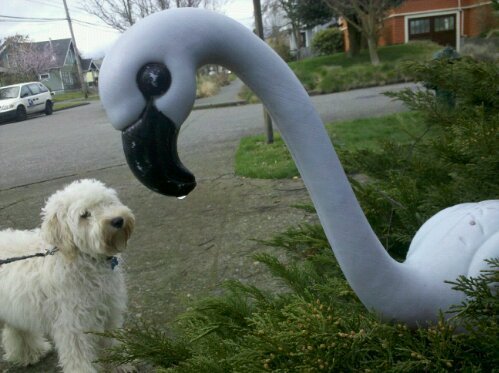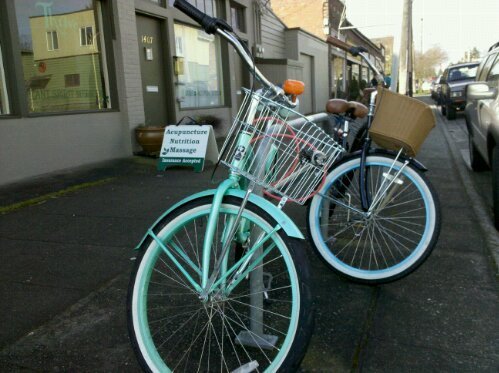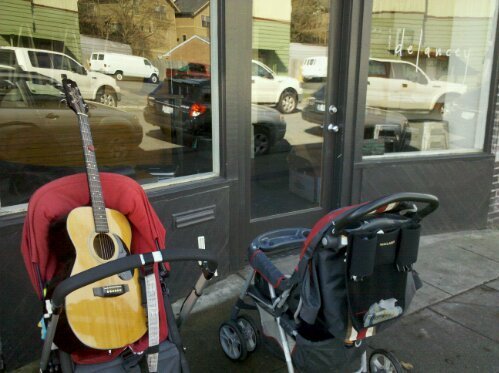Neal Thompson's Blog: Blood & Whiskey, page 10
May 1, 2011
50th anniversary of Alan Shepard, and America, in space
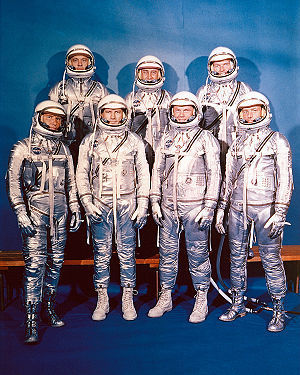
Image via Wikipedia
In advance of the anniversary of the day Alan Shepard became America's first spaceman (5/5/61), I'm posting Light This Candle excerpts this week, along with photos and links related to Shepard and the book. Here's a sample from Chapter 9, "We made them heroes, the first day they were picked"
One day in January of 1959, Shepard was reading the New York Times and came across an article about a new space agency that had been created a month earlier.
The political hysteria that had followed Sputnik resulted in the creation of an umbrella organization for the nation's best scientists and engineers: the National Aeronautics and Space Administration (NASA), a government-funded civilian agency whose primary goal would be to regain lost ground in the Cold War, prove to the world that Sputnik was a fluke, and beat the Russians into outer space. NASA absorbed a number of scientific agencies, including the National Advisory Committee for Aeronautics, which had been a driving force behind many of the rocket-powered Mach 2 and Mach 3 jet flights of the 1950s. Rocket scientists and their visions of launching missiles into space had been commandeered as soldier in the Cold War, and instead of sending satellites aloft, their new mission would be to send an American man. NASA was unveiled on December, 17, 1958 – the anniversary of the Wright brothers' first flight.
In the Times, Shepard read that NASA planned to invite 110 of the military's top test pilots to volunteer for a special mission – to become what NASA chose to call an "astronaut," which is Greek for "space sailor." Shepard read how, after ruling out daredevils and acrobats, race car drivers and mountaineers, NASA had decided it wanted steely, technology-savvy test pilots – who were also optimal choices because they happened to be on the government payroll. The candidates had to be shorter than five-foot-eleven (so they could fit into the tiny space capsule NASA was designing) and between 25 and 40 years old – NASA wanted mature pilots who'd been around, been tested and stuck it out. "Not," said an Air Force doctor who would help choose the astronauts, "those who would be enamored of the project at the outset then lose interest when the luster became worn by very hard work."
Following his year of academia at the Naval War College in Rhode Island, Shepard had been transferred to the Navy's Atlantic Fleet headquarters in Norfolk, Virginia, where the family had relocated and where he now served as "aircraft readiness officer," working with the commander of the Navy's Atlantic Fleet. Though he was not currently a test pilot, Shepard figured his name would be near the top of NASA's list. But by Friday of that week, he'd heard through the grapevine and in the halls of his Norfolk office that many of his test pilot colleagues had received invitations to come to the Pentagon for a secret briefing. Where the hell was his invitation? If they're looking for test pilots, he thought, shouldn't they be asking the Navy's best test pilot? He left work that night, angry and a little chagrined, the start of what he'd later call a "miserable weekend." He'd joke years later that he went home and "kicked the dog, spanked the children. It was a terrible weekend. It really was."
Louise could tell her husband was in a funk, which was rare for him. So, when he asked her what she thought of the whole astronaut thing, she tried to be upbeat. "How would you feel if I was one of the 110?" he asked. "It doesn't really matter because you're not," she said. "But if you were, I'd say, 'Just go right ahead.' I think it sounds wonderful."
Then, first thing Monday morning, a young staffer came up to Shepard and handed him an envelope. Inside was NASA's invitation. It had arrived the previous week. "Somehow it got misplaced," the sheepish young officer said, and Shepard didn't know whether to punch him or promote him.
He rushed home for lunch to tell Louise, who knew before he opened his mouth because Shepard was beaming from ear to ear. That night, he and Louise had a long talk about what this meant, for him and for the family. And he asked her what they should do if he actually got selected. "Why are you asking me?" she said. "You know you'll do it anyway."
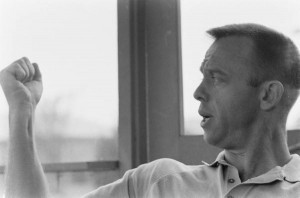

April 28, 2011
Seattle Met feature story: The Carver's Life
While researching my biography of Robert "Believe It or Not" Ripley, I learned about Ripley's visit to Seattle in 1937, when he spent $1,000 at Ye Olde Curiosity Shop. Among his purchases were a couple totem poles by a Native American carver named Sam Williams. I later learned that John Williams, who was shot and killed by Seattle police last August, was Sam's grandson. This is the story of John and his family…
[Below is an excerpt. The full story can be found at Seattle Met magazine. A video of the shooting can be found here.]
The Carver's Life
The most gifted in a long line of Native American woodcarvers, John T. Williams made striking totem poles even while succumbing to drink and life on the streets. On the day of his violent death last August, he had vowed once more to turn his life around.
The shaky video, recorded by a Seattle police officer's dashboard camera, and later played over and over in a King County courtroom, tells the end of the story. It goes like this…
A police cruiser rolls to a stop on a cloudless summer afternoon as cars and pedestrians crisscross a downtown intersection. A long-haired man limps through the crosswalk, hunched over something in his hands, then disappears offscreen. The police cruiser lurches forward, stops again. A young officer named Ian Birk gets out, his pistol already in hand, and strides toward the limping man.
"Hey," Birk yells. "Hey… Hey!"
The video notes the day and time: -August 30, 4:12:30pm. "Put the knife down," shouts Birk, now moving out of the video camera's view and onto the sidewalk. "Put the knife down. Put the knife down!" Suddenly, at 4:12:35, less than five seconds after the first "Hey": POW-POW-POW-POW-POW! A pedestrian flinches.
Birk had been listening to sports radio, whose announcers suddenly start laughing, almost as if on cue. The cruiser's police radio intrudes: "Shots fired, Boren and Howell."
Witnesses would later describe what the video failed to capture: the strangely graceful pirouette of the victim, four hollow—point bullets in his body, falling slowly backwards; the two items in his hands clattering to the sidewalk beside his bleeding body. To his left, a scrap of wood. To his right, a single-blade pocketknife.
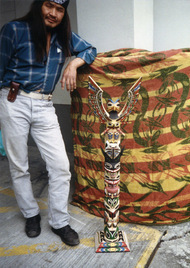
John Williams in his early 20s with one of his carvings.
The wood and the knife. They'd been John T. Williams's constant companions and among his only possessions for most of his 50 years. Throughout an abusive and violent boyhood and an equally difficult adulthood on the streets of Seattle, the pocketknife had become an extension of himself, its blade shaping two-by-two and four-by-four lengths of yellow cedar and sugar pine into the caricatured faces of bears, wolves, beavers, and ravens, works of art that sold for hundreds, sometimes thousands of dollars. The wood -Williams clutched in his calloused hand that August afternoon contained the preliminary etchings of an eagle, similar to the bald eagle spreading its wings upon his tattered cap, which read "Native Pride."
Anyone who's visited downtown Seattle has seen Williams or others like him, his street brothers and sisters, his real brothers and sisters. Though native peoples have been a downtown fixture since the city was named for one of their own, a conspiracy of factors—from limited formal education to discrimination to addiction woes—has condemned many to a hardscrabble lifestyle. Some gather daily beneath the totems in Pioneer Square or beside the fountains at Westlake Center. Some beg for change, clutching empty Starbucks cups, or peddle copies of Real Change newspapers outside storefronts. And some, like Williams, sit on the benches of "Indian Park," as some Native Americans call Victor Steinbrueck Park, near Pike Place Market, where they carve totem poles and wooden masks and plaques for tourists.
"What did you do?" shouts a passerby. "Did you shoot that man?"
Birk, frozen and apparently in shock, keeps his black Glock aimed at the prone and dying Indian.
"Ma'am, he had a knife and he wouldn't drop it," Birk says.
More officers arrive, and Birk begins to explain, "Yeah, he had the knife open." Another officer tells Birk he did a "good job."
But then police and witnesses notice: The knife's three-inch blade is closed.
Meanwhile, two of Williams's brothers sit waiting for him at Indian Park. John hadn't seen older brother Rick and younger brother Eric in months, but they'd all reunited two days earlier and they'd been carving together that morning, side by side on a park bench, just as they had since childhood. John started working on his eagle, then left around midday to get some beer. He had been shuffling along Howell Street that afternoon, back toward Rick and Eric, who continued to wait, still carving on the park bench, while a dozen blocks away police handcuffed their now dead brother.
If you have read about Williams's death, about the police department's admission that the shooting was unjustified, about Birk's resignation and the King County prosecutor's decision not to press charges against him, you'd be forgiven for thinking it was the sad, inevitable end to the hard life of a homeless Indian. But you'd be missing the rest of the story.
The story of John T. Williams is as tragic as you'd expect. Less expected is the story of a close-knit and loving family of talented artists whose history is entwined with Seattle's.
[To read the rest, visit Seattle Met]
Finally, here's a photo I took of John's brother, Rick, who cooperated with the story. He's been working (at Seattle Center) on a 32-foot memorial totem pole in his brother's honor. He's holding a replica of the memorial pole.
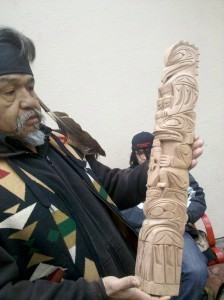
Rick Williams

April 5, 2011
Review: A Young Man's Guide to Late Capitalism
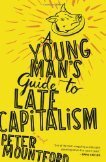 A Young Man's Guide to Late Capitalism by Peter Mountford
A Young Man's Guide to Late Capitalism by Peter Mountford
My rating: 4 of 5 stars
In one chapter of my forthcoming biography of Robert Ripley, I recount the eccentric, world-traveling "Believe It or Not" cartoonist's months-long journey through South America in 1925, during which Ripley writes that Bolivia's sky-high capital, La Paz, looked as if someone had flung the city of Reno into the Grand Canyon. So when fellow Seattleite Peter Mountford, a friend of a former newspaper colleague, offered to send me an advance copy of his first novel, which takes place in La Paz in late 2005, I figured I'd skim the book and see what had become of the city Ripley called "the most startling sight I have ever seen!" What an unexpected treat, then, to discover that Mountford is a smart, gifted writer, and a real craftsman. He tells the story of a transformational month in the life of Gabriel de Boya, an eager but conflicted young researcher for a New York hedge fund posing as a freelance journalist and struggling with greed, love, lies, and desire. Mountford's writing is admirably restrained, visual and visceral, and the result is taut, poetic, sad, and at times quite moving. Though set in 2005, the story feels fresh and relevant, deftly capturing the deceitful, manipulative world of hedge funds and foreign investment. Gabriel's lover, Lenka Villarobles, the stunning press secretary to the newly elected president, emerges as the book's heroine, it's moral center. It's often painful to be inside Gabriel's head, rooting for him as he wrestles sloppily with his life's decision: love or money. He can't have it both ways, and the tension builds as Gabriel's deceptions mount and overlap. Mountford's empathy (and, at times, sympathy) for Bolivia and its people shines through, and his sometimes loving descriptions of the gritty, impoverished city are aching and poignant – even more beautiful than Ripley's.
Look for my upcoming interview with Peter at NealThompson.com.
In the meantime, trust me, buy this book.
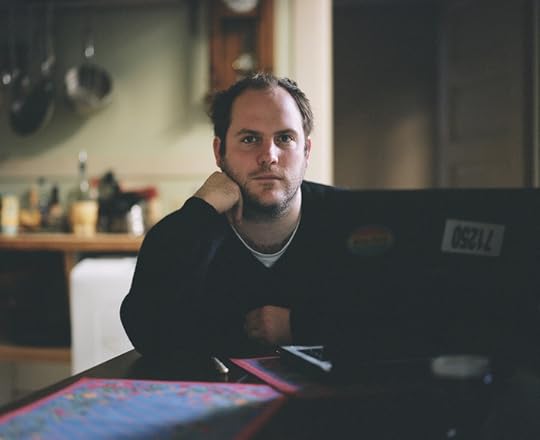

March 28, 2011
Review: Spooner
My rating: 2 of 5 stars
Sorry… I love Pete Dexter, and have read most of his books. Reading 'Paris Trout' and 'God's Pocket' (while living on the edge of the same South Philly neighborhood featured in 'God's Pocket,' where he got his ass kicked terribly by bat-wielding thugs) were memorable reading experiences. As a journalist, I'm inspired by his transformation from newsman to novelist. And as a columnist, he was fearless (I highly recommend 'Paper Trails'.) Now that I live in the Pacific Northwest, not far from Dexter's Whidbey Island home, I desperately wanted to love his somewhat autobiographical 'Spooner'. But, I hate to say it… I got bored, and (a rarity for me) quit reading halfway through. Sorry, Pete… still a fan, though.
March 25, 2011
Ireland and the Irish: sentences from Michael Lewis
 Last night, while drinking Guinness and reading Pete Dexter's Spooner, I took a break to catch up on that menacing, guilt-inducing stack of magazines. I got pulled into a Vanity Fair piece by Michael Lewis, and was quickly reminded why he's among the best non-fiction writers alive. In describing Ireland's financial collapse, he manages to capture and summarize Irish culture and history (prompting me to switch from Guinness to Powers). As an Irish citizen (you can read that story here), I'm impressed by a writer who can portray the complicated psyche of Ireland in all it's non-touristy messiness. Here are ten samples:
Last night, while drinking Guinness and reading Pete Dexter's Spooner, I took a break to catch up on that menacing, guilt-inducing stack of magazines. I got pulled into a Vanity Fair piece by Michael Lewis, and was quickly reminded why he's among the best non-fiction writers alive. In describing Ireland's financial collapse, he manages to capture and summarize Irish culture and history (prompting me to switch from Guinness to Powers). As an Irish citizen (you can read that story here), I'm impressed by a writer who can portray the complicated psyche of Ireland in all it's non-touristy messiness. Here are ten samples:
-Ireland's financial disaster … was created by the sort of men who ignore their wives' suggestion that maybe they should stop and ask for directions.
-Left alone in a dark room with a pile of money, the Irish decided what they really wanted to do with it was buy Ireland.
-When you fly into Dublin you are traveling, for the first time in 15 years, against the traffic. The Irish are once again leaving Ireland.
-Walk the streets at night and, through restaurant windows, you see important-looking men in suits, dining alone, studying important-looking papers. In some new and strange way, Dublin is now an occupied city: Hanoi, circa 1950.
-The politicians in Ireland speak Gaelic the way the Real Housewives of Orange County speak French. To ask "Why bother to speak it at all?" is of course to miss the point.
-The Irish people and their country are like lovers whose passion is heightened by their suspicion that they will probably wind up leaving each other.
-Anyone who has been anywhere near an Irish Catholic family knows the member who has had the most recent run of bad luck enjoys exalted status – the right to do pretty much whatever he wants, while everyone else squirms in silence.
-Normalizing a freak show is now a meaningful part of the job of being Ireland's finance minister. At just the moment the crazy uncle leapt from the cellar, the drunken aunt lurched through the front door and, in front of the entire family and many important guests, they carved each other to bits with hunting knives. Daddy must now reassure eyewitnesses that they didn't see what they think they saw … The finance minister might as well be standing in Pompeii and saying that actually the volcano wasn't really worth mentioning. Just a little lava!
-Two things strike an American when he comes to Ireland: how small it is and how tight-lipped. An Irish person with a personal problem takes it into a hole with him, like a squirrel with a nut before winter. He tortures himself and sometimes his loved ones too.
*And, my favorite: The famous Irish gift of gab is a cover for all the things they aren't telling you.
Here's the full Vanity Fair story. And here's his previous, equally impressive story on the debt crisis in Greece (part of his three-part Euro DisasterLand series).

Ireland and the Irish: ten sentences from Michael Lewis
 Last night, while drinking Guinness and reading Pete Dexter's Spooner, I took a break to catch up on that menacing, guilt-inducing stack of magazines. I got pulled into a Vanity Fair piece by Michael Lewis, and was quickly reminded why he's among the best non-fiction writers alive. In describing Ireland's financial collapse, he manages to capture and summarize Irish culture and history (prompting me to switch from Guinness to Powers). As an Irish citizen (you can read that story here), I'm impressed by a writer who can portray the complicated psyche of Ireland in all it's non-touristy messiness. Here are ten samples:
Last night, while drinking Guinness and reading Pete Dexter's Spooner, I took a break to catch up on that menacing, guilt-inducing stack of magazines. I got pulled into a Vanity Fair piece by Michael Lewis, and was quickly reminded why he's among the best non-fiction writers alive. In describing Ireland's financial collapse, he manages to capture and summarize Irish culture and history (prompting me to switch from Guinness to Powers). As an Irish citizen (you can read that story here), I'm impressed by a writer who can portray the complicated psyche of Ireland in all it's non-touristy messiness. Here are ten samples:
-Ireland's financial disaster … was created by the sort of men who ignore their wives' suggestion that maybe they should stop and ask for directions.
-Left alone in a dark room with a pile of money, the Irish decided what they really wanted to do with it was buy Ireland.
-When you fly into Dublin you are traveling, for the first time in 15 years, against the traffic. The Irish are once again leaving Ireland.
-Walk the streets at night and, through restaurant windows, you see important-looking men in suits, dining alone, studying important-looking papers. In some new and strange way, Dublin is now an occupied city: Hanoi, circa 1950.
-The politicians in Ireland speak Gaelic the way the Real Housewives of Orange County speak French. To ask "Why bother to speak it at all?" is of course to miss the point.
-The Irish people and their country are like lovers whose passion is heightened by their suspicion that they will probably wind up leaving each other.
-Anyone who has been anywhere near an Irish Catholic family knows the member who has had the most recent run of bad luck enjoys exalted status – the right to do pretty much whatever he wants, while everyone else squirms in silence.
-Normalizing a freak show is now a meaningful part of the job of being Ireland's finance minister. At just the moment the crazy uncle leapt from the cellar, the drunken aunt lurched through the front door and, in front of the entire family and many important guests, they carved each other to bits with hunting knives. Daddy must now reassure eyewitnesses that they didn't see what they think they saw … The finance minister might as well be standing in Pompeii and saying that actually the volcano wasn't really worth mentioning. Just a little lava!
-Two things strike an American when he comes to Ireland: how small it is and how tight-lipped. An Irish person with a personal problem takes it into a hole with him, like a squirrel with a nut before winter. He tortures himself and sometimes his loved ones too.
*And, my favorite: The famous Irish gift of gab is a cover for all the things they aren't telling you.
Here's the full Vanity Fair story. And here's his previous, equally impressive story on the debt crisis in Greece (part of his three-part Euro DisasterLand series).


March 23, 2011
Dog View Daily
March 21, 2011
My interview with author Karen Abbott

I'd briefly met Karen a few years ago in Asheville, NC, during her tour for her first book, Sin in the Second City. She visited Seattle last month to talk at Elliott Bay Book Co. about her new book, American Rose, a biography of Seattle-born Gypsy Rose Lee.
We talked about writing, her naughty parrots, Freedom, and the theme song from Rocky.
[Links: Here's Karen's website, and here's some video of Gypsy stripping - and, bravely, hilariously, Karen.]

Dog View Daily
March 19, 2011
Dog View Daily
Saturday morning, from Mickey's perspective.
Experimental blog posts/pix from Mickey the dog via Droid






